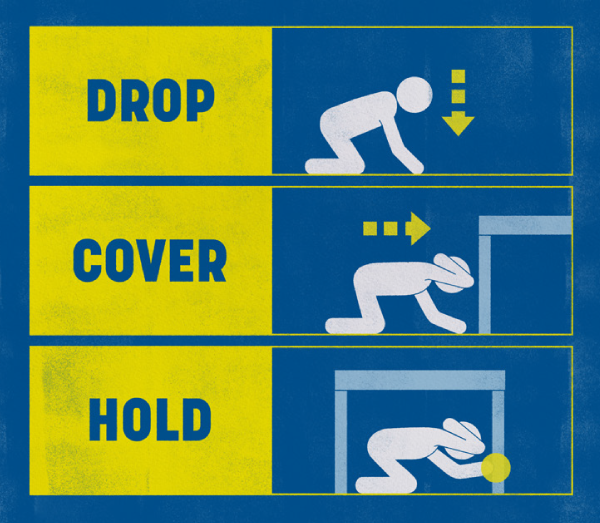Get Tsunami Ready
All of New Zealand is at risk of earthquakes and all of our coastline is at risk of tsunami. We can’t predict when one will happen, but we can protect ourselves and our family.
- When an earthquake happens
- If you are near the coast
- Where do tsunami come from?
- Tsunami evacuation zones
- Share our resources
- Tsunami monitoring and detection network
When an earthquake happens
 Drop, Cover and Hold is the right action to take in an earthquake.
Drop, Cover and Hold is the right action to take in an earthquake.
It stops you being knocked over, makes you a smaller target for falling and flying objects and protects your head, neck and vital organs.
- DROP down on your hands and knees. This protects you from falling but lets you move if you need to.
- COVER your head and neck (or your entire body if possible) under a sturdy table or desk (if it is within a few steps of you). If there is no shelter nearby, and cover your head and neck with your arms and hands.
- HOLD on to your shelter (or your position to protect your head and neck) until the shaking stops. If the shaking shifts your shelter around, move with it.
If there is no shelter near you crawl to an inside corner of the room and cover your head and neck with your hands and arms.
Many people are injured while trying to move DURING the shaking. It is safer to Drop, Cover, and Hold until the shaking is over.
Drop, Cover, Hold - video
If you are near the coast
If you are near the coast and feel an earthquake that is LONG or STRONG: GET GONE.
A tsunami is a series of waves caused by large earthquakes. All of New Zealand’s coast line is at risk of tsunami. A tsunami wave can grow to become a fast moving wall of water.
If you are at the coast and experience any of the following:
- Feel a strong earthquake that makes it hard to stand up, or a weak rolling earthquake that lasts a minute or more
- See a sudden rise or fall in sea level
- Hear loud and unusual noises from the sea
Move immediately to the nearest high ground, or as far inland as you can. Walk or bike if possible.
Do not wait for official warnings.
For a local source tsunami which could arrive in minutes, there won’t be time for an official warning. It is important to recognise the natural warning signs and act quickly.
Remember, LONG or STRONG: GET GONE.
Long, Strong, Gone - video
Tsunami evacuation zones
Your local Civil Defence Group has tsunami evacuation zone maps and regional advice. Make sure you know where to go, whether you are at home, at work or out and about.
Where do tsunami come from?
Tsunami can come from different sources.
A distant source tsunami, like one generated from Chile, could take 14 hours or more to arrive. A regional source tsunami, like one generated from the Southwest Pacific, could take between one and three hours to arrive. In these cases we will have time to issue official warning messages.
A local source tsunami generated from an earthquake close to New Zealand, can arrive at New Zealand coastal areas within minutes.
In this case, official warnings are unlikely to be issued before damaging waves arrive, so people in coastal areas need to take immediate action – if you feel an earthquake that makes it hard to stand, or lasts more than a minute – move immediately to higher ground or as far inland as possible.
Remember: LONG OR STRONG, GET GONE.
Share our resources
We're encouraging civil defence emergency management groups, partner agencies and organisations to get involved and promote awareness of the right action to take before, during and after a tsunami.
Tsunami public education resources
Tsunami monitoring and detection network
Learn more about New Zealand’s tsunami monitoring and detection network.

